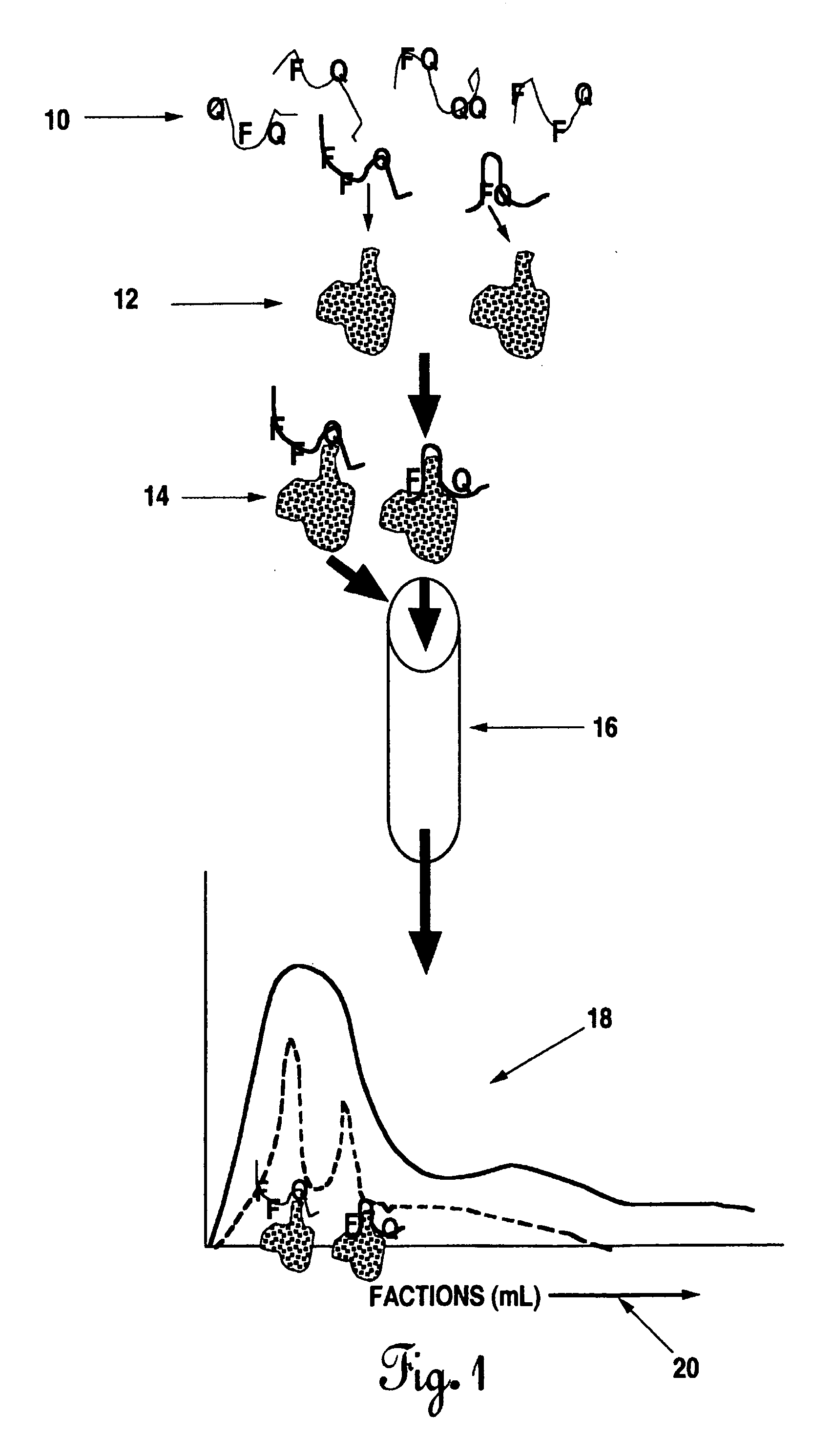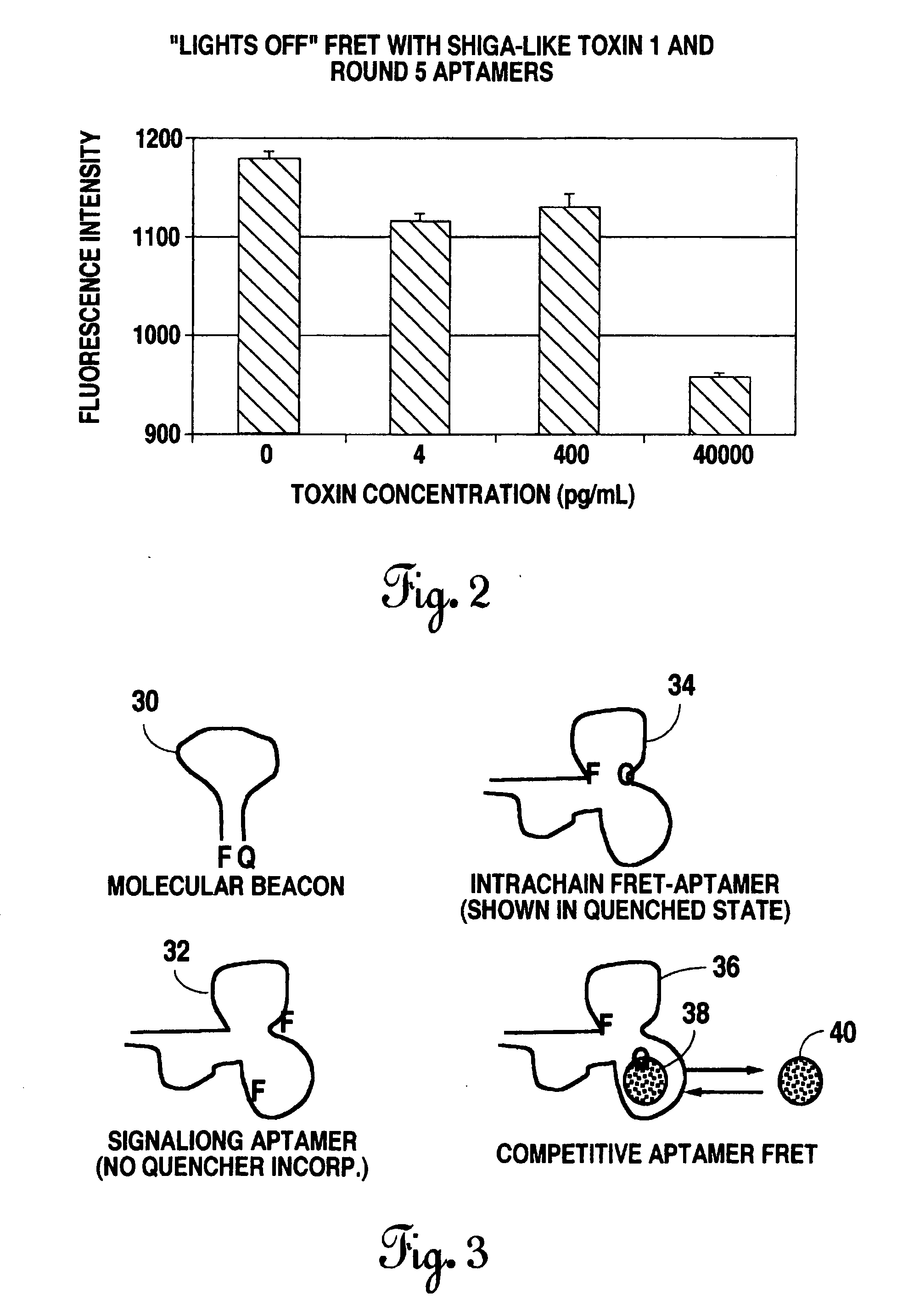Methods of producing interachain fluorophore-quencher FRET-aptamers and assays
a technology of fret-aptamer and fluorophore, which is applied in the field of aptamerand nucleic acidbased diagnostics, can solve the problems that the fret-aptamer cannot be cloned for sequencing, and achieve the effects of optimizing assay performance, enhancing f and q placement, and maximizing fret assay sensitivity and specificity
- Summary
- Abstract
- Description
- Claims
- Application Information
AI Technical Summary
Benefits of technology
Problems solved by technology
Method used
Image
Examples
example 1
Single (Intrachain) Chain FRET-Aptamer Assay for a Protein (E. coli Shiga-Like Toxin I).
[0037] Following five rounds of systematic evolution of ligands by exponential enrichment (“SELEX”) an aptamer family was subjected to PCR in the presence of 3 μM Chromatide™-dUTP and 40 μM Dabcyl-dUTP using a standard PCR mix formulation and Taq enzyme at 1 Unit per 50 μL reaction. This led to incorporation of the FRET (F and Q) pair which demonstrated the lowest background fluorescence of all F:Q ratios tested (nearly 1,200 fluorescence units for the baseline reading without the toxin target). Fluorescence readings in FIG. 2 were taken with a handheld fluorometer. Error bars in FIG. 2 represent the standard deviation of three trials and the bar heights represent the means of the 3 measurements. At the level of 40,000 picograms per milliliter (pg / mL) or 40 nanograms (ng) of Shiga-like toxin I, a definitive “lights off” FRET effect is noted. Since the mean fluorescence at 40 ng of added toxin is...
example 2
Use of Unlabeled Aptamer Nucleotide Sequences and Secondary (Stem-Loop) Structures that Can Confirm, Enhance, and Optimize FRET-aptamer Assays.
[0038] The present method enables the natural selection of FRET-aptamers. However, the method can be confirmed and enhanced by knowledge of the unlabeled aptamer sequences and structures that were selected from several rounds of SELEX before the aptamer population was “doped” with F-dNTPs and / or Q-dNTPs. FIG. 4 gives an example of BoNT A aptamer sequences that are claimed as unlabeled sequences, resulting in secondary stem-loop structures from energy minimization software using 25° C. as the nominal binding temperature. The stem-loop structures shown in FIGS. 4A-4D may be especially useful in determining if the F and Q locations are indeed logical (i.e., fall in or near a binding loop structure). In addition, if F and / or Q loci are found to be distal, information such as the secondary structures in FIGS. 4A-4D could be instrumental in slight...
PUM
| Property | Measurement | Unit |
|---|---|---|
| Forster distance | aaaaa | aaaaa |
| molecular weight | aaaaa | aaaaa |
| wavelengths | aaaaa | aaaaa |
Abstract
Description
Claims
Application Information
 Login to View More
Login to View More - R&D
- Intellectual Property
- Life Sciences
- Materials
- Tech Scout
- Unparalleled Data Quality
- Higher Quality Content
- 60% Fewer Hallucinations
Browse by: Latest US Patents, China's latest patents, Technical Efficacy Thesaurus, Application Domain, Technology Topic, Popular Technical Reports.
© 2025 PatSnap. All rights reserved.Legal|Privacy policy|Modern Slavery Act Transparency Statement|Sitemap|About US| Contact US: help@patsnap.com



